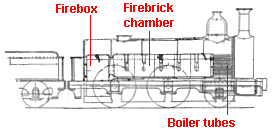Updated: 2 Mar 2010
Much more info added




Fowler's Ghost |
Updated: 2 Mar 2010 |
 | Left: The only known photograph of Fowler's Ghost, a locomotive intended to run through the tunnels of London's Metropolitan Railway without emissions, using heat stored in firebricks.
There was concern about steam and smoke emissions from the locomotives, and Sir John Fowler, the Metropolitan's Engineer, ordered an experimental locomotive designed to not produce smoke while in the tunnel sections. It was built by Robert Stephenson & Co of Newcastle-on-Tyne, in 1861, two years before the Metropolitan rails were ready, and cost £4500, which for the time seems like a great deal of money. It was tried on a few test runs, and was never seen again... |
According to Sir Benjamin Baker, who revealed some of the secrets in a paper presented to the Institute of Civil Engineers in 1885, the Ghost was a 2-4-0 design, with cylinders 15 x 24in and 6-foot driving wheels. The leading wheels were 4ft in diameter. The gauge was the broad gauge of the Great Western, 7ft 1/4 inch. The Ghost weighed 32 tons in working order, and pulled a tender carrying 1400 gallons of water, weighing another 14 tons. However, the heating surface was only 570 ft2 and the grate area 13.25 ft2. There were 189 boiler tubes of 2in diameter, but they were only 2ft 7in long. The Ghost carried a jet condenser with associated air-pump to maintain a good vacuum. Heat was stored in a massive array of fire-bricks contained in a long "combustion chamber" between the firebox and the boiler tubes.
On the 10th of October 1861, the 'Ghost' was given an initial trial on the Great Western main line, in the area of Hanwell station. It turned out to be a disastrous foray of about 7.5 miles. The boiler pressure fell rapidly and there was much difficulty in getting the locomotive back home. The condenser would not condense, but the real cause for alarm was the jamming of the boiler feed-pumps; this threatened that the boiler would overheat and as a result possibly burst. The standard action to be taken in this situation with a conventional steam locomotive was to drop the fire into the roadway as quickly as possible, a few charred sleepers being infinitely preferable to a boiler explosion. The driver of the Ghost, however, found to his horror that no provision had been made for summarily discharging several tons of incandescent bricks onto the track. In the event an explosion was avoided, and the engine got home somehow.
Another attempted trial, on home territory between King's Cross and Edgware Road, is also on record, (in The Engineer for 16 August 1895) but seems to have gone no better.
In February 1865, the Metropolitan Railway advertised that the Ghost, then lying in a siding at Hammersmith, was for sale either entire or in parts. It was bought by Mr Isaac Watt Boulton, He was a relative (the exact relationship is currently unknown) of Matthew Boulton, the partner of James Watt. Isaac Boulton ran a well-known locomotive hire business in Oldham, connected to the M S & L R by the famous "Boulton's Siding". See the bibliography below.
Since nobody wanted to buy the Ghost in its current broad-gauge form, Boulton had drawings planned for its conversion to standard gauge. This proceeded until it was ready for the fitting of a new boiler, but the pressure of more important work and "a series of untoward events" retarded progress and the conversion was still incomplete when Boulton's ceased trading in 1894. The Ghost was sold "as is" to Beyer Peacock & Co, and apparently ended up on their scrap-heap.
The experimental locomotive remained a mystery for many years, and apparently received a first-class cover-up; hence the name Fowler's Ghost.
 | Left: The internals of Fowler's Ghost.
|
The choice of fire-brick as a heat storage medium was a bad one. It would have been far better to use a normal boiler, as water, having the highest specific heat of any substance at 1.0 (metallic mercury has only 0.033, which is rather surprising) would store heat much better. A big well-lagged boiler should have done the trick.
Alternatively the fire could have been done away with altogether, and the boiler topped up with steam as required. Plenty of fireless locos have been built on this principle, but whether they could have had the range and power to work the Metropolitan is questionable. There is some evidence that a water-based fireless loco was indeed tried before the Ghost was built, but was indeed deficient in both power and range.
Ultimately both the Metropolitan and the District were worked with what might be called semi-condensing tank locomotives: these produced smoke in the normal manner, but their exhaust steam, while running in tunnels, was directed via a valve back into the water tanks and, partly at least, condensed. Since the tanks quickly got hotter and hotter the condensation became less and less effective, and the tanks had to be drained and refilled with cold water at the end of each run.
It should be said that Sir John Fowler was not an incompetent nitwit; he went on to co-design the Forth Bridge, which seems to be holding up nicely. Even great engineers are fallible; certainly the decision to use fire-bricks was a bad error of judgement.
C. Hamilton Ellis famously summed it all up: "the trouble was that her boiler not only refrained from producing smoke, it produced very little steam either".

Bibliography: much of the new information on this page is derived from the famous book "Chronicles of Boulton's Siding" by Afred Bennett. MIEE, MI Loco E. Published by The Locomotive Publishing Company Ltd, 1927.

  
|